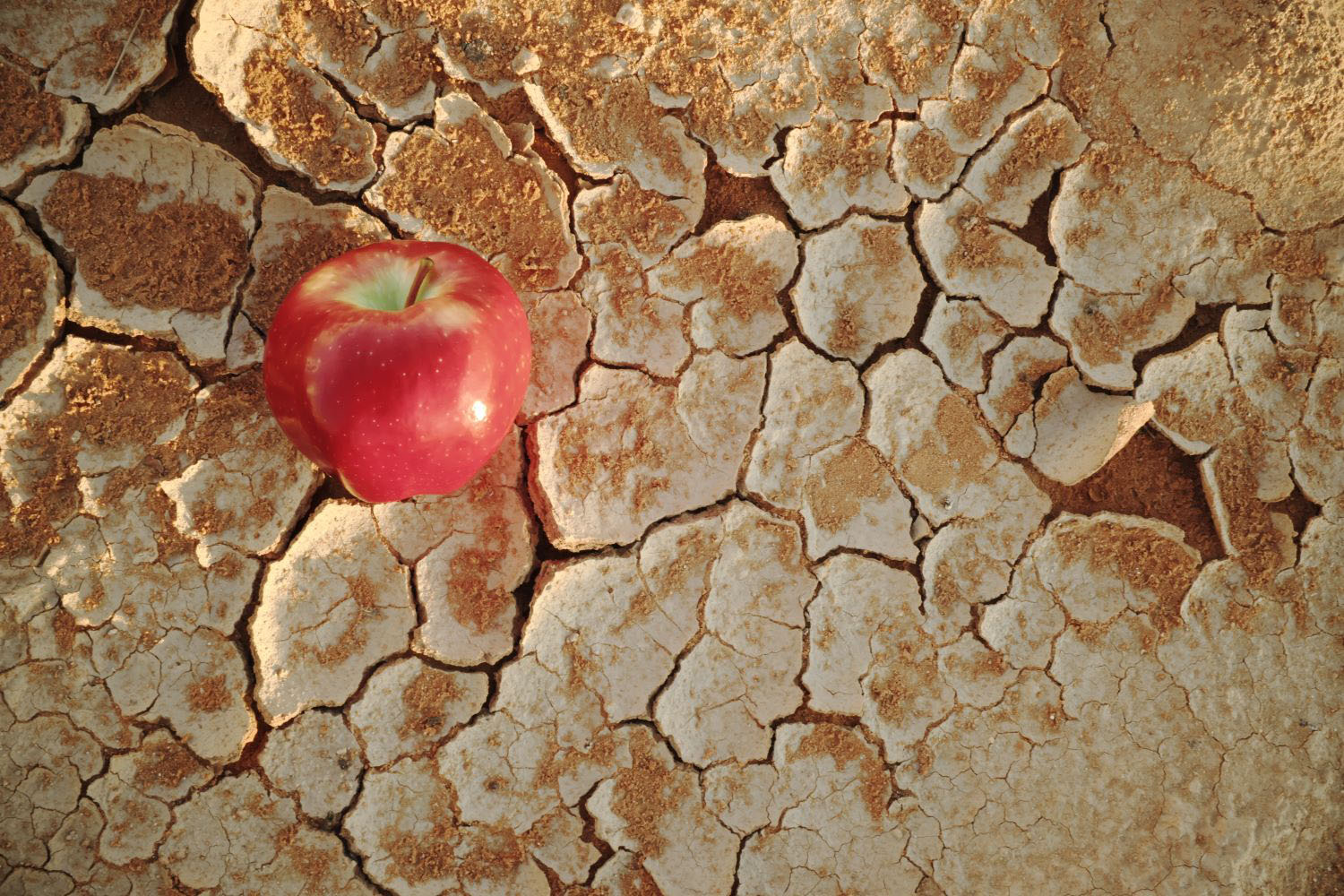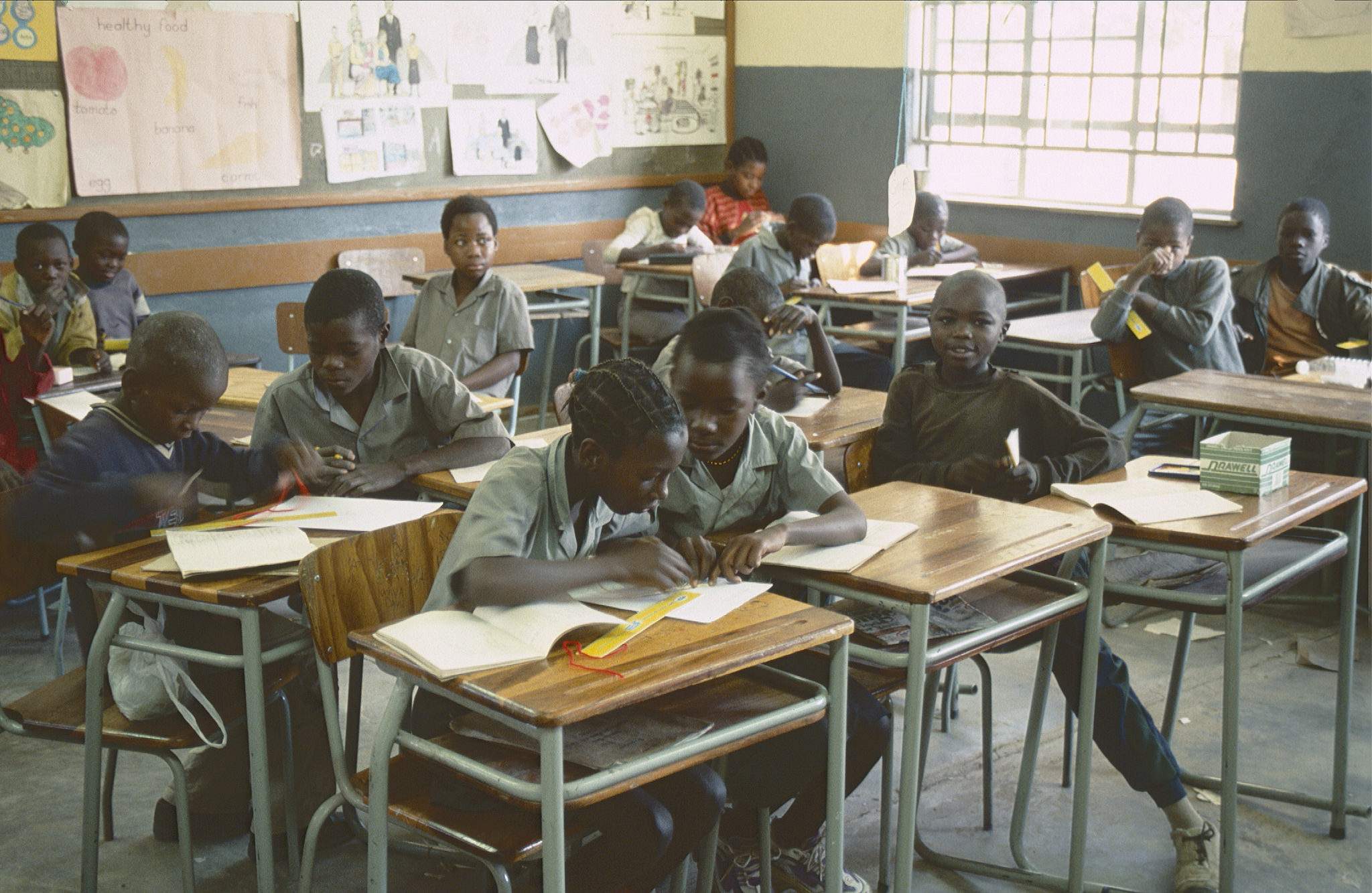In the early 2000s, subsidies and trade barriers in rich countries were driving international agricultural prices down, leaving poor farmers in developing countries struggling to support their families. Campaigns such as Oxfam’s “Make Trade Fair” brought celebrity-level attention to the harm done by transferring hundreds of billions of dollars to relatively well-off farmers in high-income countries. But just a few years later, agricultural prices spiked, countercyclical subsidies fell, and food-security concerns moved front and center as consumers rather than producers suffered.
Agricultural policies such as those targeted by Oxfam exacerbate the natural price volatility of commodity markets and put a huge burden on poor people who have neither savings nor safety nets. When commodity prices are low, subsidies push prices even lower and discourage investment in agriculture. Slashing these subsidies was a central goal of developing-country negotiators when the World Trade Organization (WTO) launched its Doha Round of trade talks in 2001. Unfortunately, deep disagreements over agriculture and food security repeatedly blocked progress, and the Doha Round lingers in a zombie-like state — neither fully dead nor really alive.
Trade is key to bringing food security to 800 million people that remain chronically undernourished
That is a shame because trade is a key tool to bring food security to an estimated 800 million people around the world that remain chronically undernourished (figure 1). Many countries need reliable access to international markets to supplement their inadequate domestic food supplies. Better policies to make agriculture in developing countries more productive and profitable, including via exports, would also help alleviate food insecurity and reduce poverty. Stronger international trade rules would help by constraining the beggar-thy-neighbor policies that distort trade, contribute to price volatility, and discourage investments in developing-country agriculture.
Figure 1
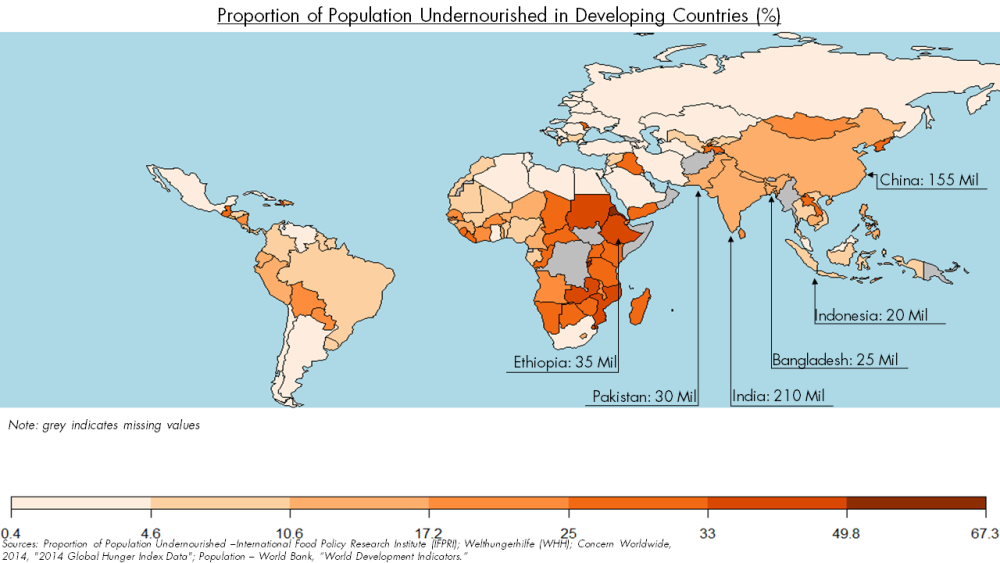
Unfortunately, the history of international agricultural negotiations is not promising. The Uruguay Round of trade negotiations, launched in Punta del Este in 1986, was the first to even try to address the array of trade-distorting agricultural policies in a serious way. Those negotiations succeeded in creating an elaborate framework of rules, but they largely failed to rein in subsidies or trade protection in industrialized countries.
The Doha Round was supposed to change that, but it collapsed around the time that food prices peaked in mid-2008. India, home to one-quarter of the world’s undernourished people, took a hard line against any significant constraints on developing countries’ freedom of action to address food security. But India’s demands for flexibility came just as the government there and in other emerging markets, including China, were increasing subsidies to farmers. Several large emerging markets are now providing levels of potentially trade-distorting support to agriculture that are comparable to those of major industrialized countries.
The changing agricultural landscape is further complicating the WTO negotiations, and an agreement to constrain and reduce agricultural subsidies seems as elusive as ever. But in India, internal pressures to reform an expensive and relatively ineffective food system are growing, and that provides reason for hope. It was only after European policymakers agreed on domestic agricultural policy reforms that changes under the Uruguay Round trade deal were no longer considered unbearably costly. Reform in India could do the same for the Doha Round.
In the meantime, while waiting to see if India will embrace reform, WTO members need to find a way to address an immediate, relatively narrow food-security issue that threatens to open a large hole in the already weak rules on agriculture. Last year, at India’s behest, the WTO agreed to allow developing countries to provide potentially trade-distorting subsidies to farmers if they are part of a public stockholding scheme. This supposedly temporary arrangement opens the door for significant new trade distorting support if it remains in place.
The Bleak History of Agricultural Trade Negotiations
Agricultural reform has long been a tough nut to crack. The United States adopted “temporary” programs in the 1930s to help farmers simultaneously battling the Dust Bowl and the Great Depression. Despite dramatic changes in the structure of American agriculture since then, more than one-quarter of total US farm receipts were courtesy of Uncle Sam as recently as 1999, according to the Organization for Economic Cooperation and Development (OECD). Japanese farmers are dwindling in number and most are 65 years old or older, yet the government still maintains a tariff of more than 700 percent to protect rice farmers. And while the European Union has reformed the Common Agricultural Policy (CAP) to make it far less trade-distorting, it still transfers tens of billions of dollars to farmers every year. [1]
While it might seem that having a relatively small number of farmers should reduce their political clout, the opposite is often true. Smaller numbers of larger, wealthier farm operations find it easier to organize and lobby to protect their interests. For most people in high-income countries, however, food is a small share of the total consumption basket. They generally will not feel strongly enough to vote, or to pony up campaign contributions, because they oppose farm subsidies.
The strength of the agricultural lobbies in key countries has also plagued efforts to negotiate international rules to discipline these policies. The General Agreement on Tariffs and Trade (GATT) was crafted by 23 developed and developing countries in 1947 to avoid trade wars like those of the Great Depression. But from the beginning there were exceptions for agriculture. GATT rules prohibited export subsidies and import quotas for manufactured products, but allowed them for agricultural commodities. Import tariffs are often higher for agricultural commodities than for manufactured goods.
In 1955, the Eisenhower administration bowed to pressure from Congress and requested a waiver from the GATT’s already loose rules to protect US support for sugar, dairy, and other sensitive products. This was a move that subsequent generations of US trade negotiators would deeply regret. The overall result was that countries designed their agricultural policies to satisfy domestic political constituents with little or no concern for the impact on others.
Just a few years after getting an exemption from international rules for its own policies, the United States found itself battling the European Economic Community in the “Chicken War.” US negotiators retaliated against European restrictions on poultry imports by imposing a 25 percent tariff on US imports of small trucks (Volkswagen was exporting them then). The GATT could do little, the tariff remains in place today, and the spat was just the first of many transatlantic food fights.
By the 1980s, the costs of Europe’s CAP were escalating; US agricultural exports were tanking from the combination of European export subsidies and a strong dollar; and Brazil and other developing countries were increasingly frustrated at having to compete against rich country subsidies. It was not the only important item on the agenda, but reducing trade-distorting agricultural policies was a major motivation for many GATT members when they launched the Uruguay Round in 1986. That round ended three years late and only after European policymakers adopted reforms to the CAP that gave them the policy space to settle their disputes with the United States and agree to international disciplines.
The Uruguay Round Agreement on Agriculture proved to be yet another disappointment, however. On the positive side, agricultural policies were, for the first time, subject to constraints under international trade rules. But European negotiators ensured that the rules reflected the modest reforms they had already adopted; Japanese negotiators insisted on keeping tight restrictions on rice imports; and the United States took advantage of the Japanese position to retain protection for sugar, dairy, and other sensitive products.
Overall, the constraints were loose enough that they had little impact in practice. But, as the European Union continued to expand south and east, agricultural support threatened to consume more and more of the budget. EU policymakers steadily expanded and deepened their CAP reforms, using the Uruguay Round framework as a guide.
Rising Food Prices Help Kill the Doha Round
When the WTO (which replaced the GATT in 1995) decided to launch a new round of negotiations in Doha in 2001, real agricultural prices were near historic lows (figure 2). Tightening the rules on price-depressing agricultural subsidies and trade barriers was again at the center of international trade negotiations. This time, however, Brazil and other developing-country exporters were in the forefront demanding reform. US farmers saw the round as an opportunity to increase market access in developing countries, but they were also increasingly on the defensive over American subsidy programs.
Figure 2
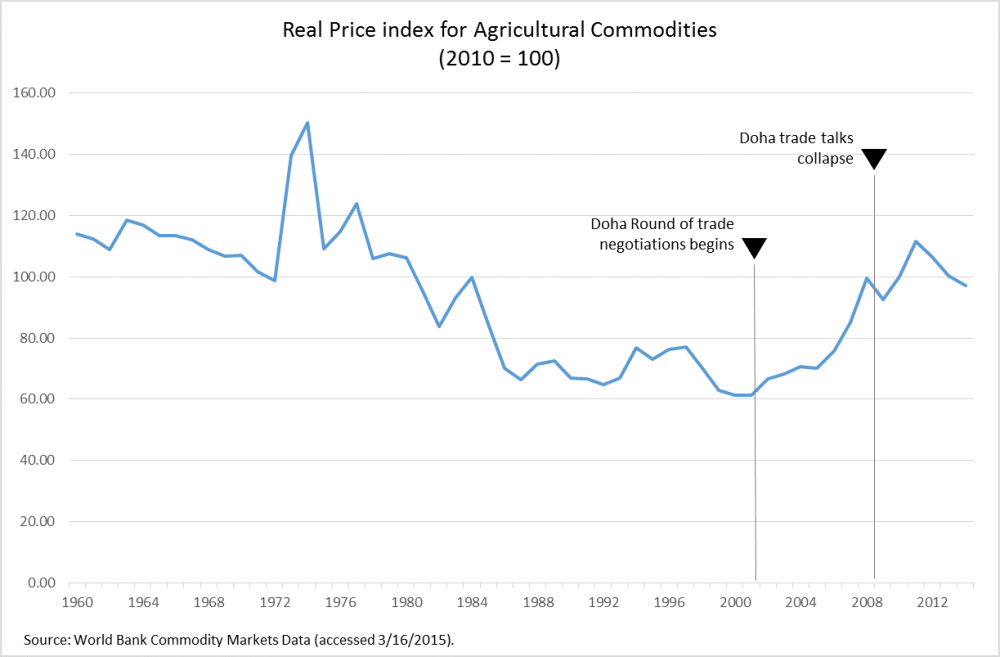
Then food prices began to rise and things changed dramatically. Although food prices have been up and down in recent years, they remain well above the levels of the mid-2000s. And that shifted global attention from the effects of low commodity prices on poor producers to the effect of high food prices on poor consumers. Many developing country governments tried to insulate consumers from price spikes. According to the FAO, 25 countries imposed restrictions on food exports in 2007-08; import-dependent countries also lowered tariffs and taxes on food. Russian restrictions on wheat exports contributed to a second round of price spikes in 2010. These policies made sense to each country individually, but in the aggregate they drove global food prices even higher and left everyone worse off. Export restrictions also tend to undermine food security in the long run because they reduce incentives to expand production. Unfortunately, export restrictions in agriculture, like export subsidies, have few constraints under WTO rules.
Although it lingers on life support, the Doha Round effectively died at a ministerial meeting in August 2008. Paradoxically, the 2008 ministerial broke down largely because American and Indian negotiators could not resolve a disagreement over how much latitude developing countries should have to raise tariffs when prices are falling and imports are surging. [2] In essence, India’s negotiating stance since then has been that the WTO should permit developing countries to do pretty much anything in the name of food security, whatever the costs to their own or other countries.
When WTO members tried to revive the round in 2013, India held up agreement on a modest and relatively uncontroversial package of trade facilitation measures until its food security concerns were addressed. WTO members eventually acquiesced to India’s demand to temporarily forgo challenges to public stockholding programs, like India’s, that also incorporate potentially trade-distorting price support for farmers. [3] The following summer, India blocked the first steps toward implementation of the trade facilitation agreement because it did not think progress on a permanent solution for its food security concerns was fast enough. US and other negotiators agreed to shift the deadline for finding a solution from 2017 to the end of 2015.
India’s Food-Security Concerns and the Need for Domestic Reform
There is no question that India faces huge food-security challenges. It is home to one-quarter of all the undernourished people worldwide (figure 1). And nearly half of all children in the country and one-third of adults aged 15 to 49 are malnourished, according to the World Food Programme. So the government’s concerns are understandable.
No doubt, India faces huge food-security challenges. It is home to 1/4 of all undernourished people worldwide.
But India may well come to view the WTO arrangement on food security as a pyrrhic victory. The current approach is hugely expensive and inefficient. [4] In 2013, the Congress Party-led government adopted the Food Security Act, which made food security a right and expanded the existing food distribution program. The program promises 5 kilograms per month of heavily subsidized rice, wheat or coarse grains to 75 percent of Indians in rural areas and up to 50 percent of those in urban areas that are near or below the poverty line (almost 70 percent of the total population). To support producers, the government buys the food for the program at prices calculated to cover costs.
The new government of Prime Minister Narendra Modi recognizes the need for reform. In the summer of 2014, he appointed a high-level committee to study the operation of India’s food procurement system. In addition to finding that much of the food procured for distribution to the poor was being lost to mismanagement and corruption, the committee concluded that two other key objectives were not being met: [5]
- Only 6 percent of farmers receive market price support from procurement.
- Buffer stocks are larger than needed, leading to high storage costs and wasted food.
The group recommended that the government focus on those most in need and reduce the coverage of the program from two-thirds of the population to 40 percent. The committee then suggested raising the benefit for the smaller group from 5 kilograms to 7 kilograms of grain, while reducing the amount of the price subsidy for all but the poorest 10 percent of recipients. The committee also recommended moving gradually to replace in-kind transfers with cash, first in large states and then in states with grain surpluses. States with grain deficits would be allowed to choose between cash and in-kind transfers.
Shortly after the group released its report, the Modi government released the 2014-15 Indian Economic Survey, which provides information and analysis to support the 2016 budget proposal. In the survey, government economists estimated that the direct costs of the subsidies on rice and wheat were equal to 1.14 percent of 2011 GDP. The survey also found evidence of significant leakage, with as much as 15 percent of the rice and nearly half of the wheat not getting to intended beneficiaries.
The analysis in the Economic Survey also affirmed the merits of the high level committee’s recommendation to move to direct cash transfers. But the survey’s authors concluded that building the capacity to do that would take time. They focused on narrow, technical reforms to make the public distribution system more efficient in the interim. And, in a sign of the political difficulties in cutting subsidies, some in the government embraced the high-level commission’s recommendation to increase the amount of food distributed, while rejecting the proposed reduction in coverage.
This is the system that India wants so desperately to protect that it repeatedly held the entire WTO agenda hostage. As I explore below, there is a relatively modest tweak to the trade rules that could buy India the time it needs to reform its programs, without undermining the trade system. With that fix, and contrary to the impression left by Indian negotiators, the current rules are not all that constraining for developing countries.
Are WTO Rules for Developing-Country Agriculture Too Tight?
When the Uruguay Round Agreement on Agriculture (URAA) was concluded, few developing countries were providing subsidies to agriculture. Most were focused on manufacturing more than agriculture and were concerned with keeping food prices low for urban consumers. The policy tool of choice for developing countries at the time was to impose tariffs that were either unbound under international rules or bound at very high levels. The gap between developing countries’ bound and applied tariffs is often large, leaving governments with substantial flexibility to raise or lower them in response to changing market conditions.
As part of the URAA, countries that were providing trade-distorting subsidies to farmers had to cap and then reduce them. The caps were generally set at relatively high levels and were rarely binding. But because most developing countries were not providing such subsidies, and did not anticipate doing so, only a dozen or so made formal commitments to set caps. The remaining countries were bound by the agreement’s de minimis limits on trade-distorting subsidies and market price support. Those limits are set at 10 percent of the value of production for support to specific products, and 10 percent of the value of total agricultural production for non-product-specific support.
But this is only a fraction of the policy space developing countries have under the URAA. There is a “green box” for all member countries that allows unlimited support as long as it has no or only minimal effects on trade or production. Examples include research, extension services, and income support for farmers, as long as it is decoupled from production decisions. There is also a “development box” that provides additional flexibility for developing countries to provide input subsidies for low-income farmers and investment subsidies, if they are generally available for agriculture.
There are also no limits on the size of the subsidies that countries can provide to food insecure consumers via public stockholding and domestic food aid schemes, as long as the procurement of food stocks is at market prices. But, if governments procure food from farmers at “administered” prices that are above reference prices set in the Uruguay Round agreement, then it counts as trade-distorting support that counts against the de minimis ceilings. The value of that market price support is calculated as the price wedge (administered price minus the reference price) times “eligible production.” The problem is that the reference prices are 30 years old (based on 1985-86 world prices), and there is no adjustment for inflation or exchange rate changes.
There are also no limits on the size of the subsidies that countries can provide to food insecure consumers via public stockholding and domestic food aid schemes, as long as the procurement of food stocks is at market prices.
This is where India’s food security programs run into trouble. India procures rice, wheat, and a few other staple commodities at government-set prices and then sells them at heavily subsidized prices to the poor. India’s most recent WTO notification shows that the calculated market price support is still within its de minimis limits. But India’s administered prices have been rising in recent years, and the amount of market price support, as calculated under WTO rules, has been rising sharply as well, especially for rice.
But the calculation under the WTO rules has no connection to current market conditions and makes little economic sense. According to India’s WTO notification, the administered price for rice in 2010-11 was $329 per metric ton, above the 1985-86 reference price of $293 per metric ton. That led to a calculation of $2.3 billion in market price support for rice. But according to World Bank data, the average world price of the cheapest variety of Thai rice in 2010-11 was over $400 per metric ton.
So India is on solid ground in seeking changes to this rule. But its other demands are extreme. With varying degrees of support from members of the G-33 group of food-importing countries, India demanded a broad exemption for public stockholding programs from the definition of trade-distorting support. Specifically, it wants to move these programs to the green box, even when they employ administered procurement prices that clearly have the potential to be trade-distorting. If the government’s reference price were to rise above world market prices, which is what experience suggests will eventually happen, the government would either have to raise trade barriers to stem imports, or acquire even more stocks to maintain the target price. And if stocks begin to accumulate, the government may be tempted to unload them on world markets, displacing production and suppressing prices in other developing countries.
But the American position is even more puzzling. US negotiators refused to do the obvious and negotiate changes to the rule for calculating market price support. Revisiting that decision is the key to preventing another impasse in Geneva.
Are WTO Rules Too Loose?
According to estimates compiled by the OECD, several large emerging markets, including Turkey and Russia, provide relatively high levels of support to agricultural producers. As a share of total farm receipts, producer support is comparable to the OECD average in those countries, as well as China and India. Whether because of reform, as in the European Union, or because higher prices automatically reduce countercyclical subsidies in the United States, producer support in industrialized countries, by contrast, has generally been declining (figure 3).
Figure 3
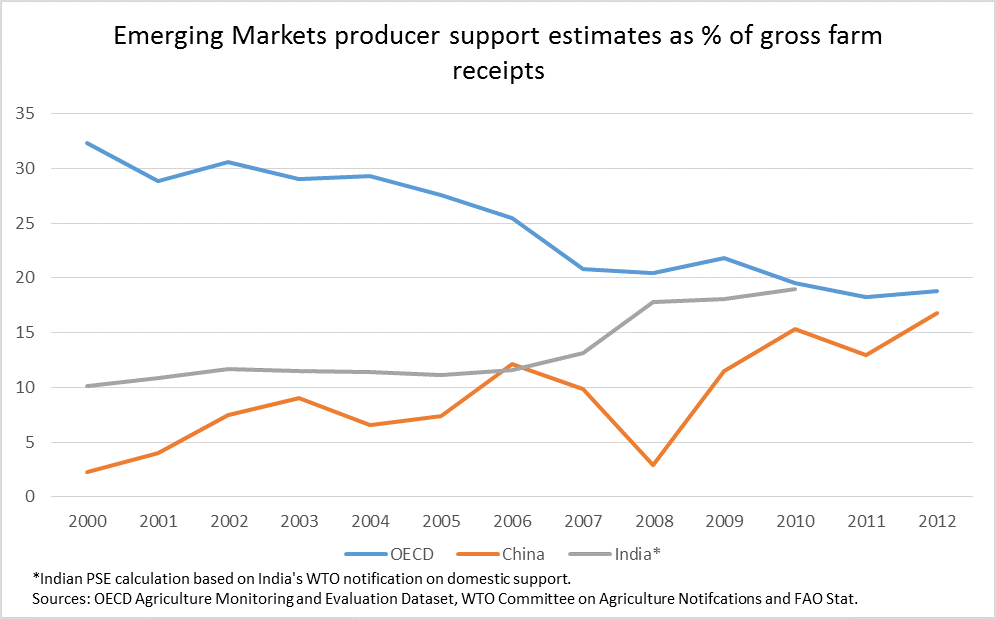
The levels of support in India and China already represent large shares of total national income, and they appear to still be rising. In its WTO notification for 2010-11, India reported providing almost $25 billion in green box subsidies, roughly four times higher than India reported for 2004–05. The report lists $5.6 billion for research, $3.3 billion for concessional loans and debt relief, and $1.4 billion for public stockholding. But the details of most of the rest are missing, so there is no way to know whether India is appropriately allocating that spending to the green box. India also reported providing $29 billion in input subsidies and a bit over $2 billion in market price support for rice, all up sharply from earlier years. All told, what India reported spending on agriculture was roughly 3 percent of its GDP.
China’s agricultural support expenditures are also high and growing. In its most recent WTO notification, which only goes to 2008, China reported 593 billion renminbi in green box spending ($85 billion at market rates); that was almost twice the 310 billion renminbi reported for 2005. The largest single item, accounting for almost 30 percent of the total, was a grab bag of miscellaneous “general services,” including buildings, facilities, and salaries and pensions for government employees. In 2008, China also reported spending 78 billion renminbi ($11 billion) for input subsidies, up from $2 billion in 2005, and a relatively modest amount—15 billion renminbi ($2 billion)—in price support for rice, corn, cotton, and pork. China reported that it was not close to the 10 percent de minimis limit for any of those products. The Chinese total is also around 3 percent of its GDP.
China, which joined the WTO in 2001, uses an updated reference period for calculating market price support, but it still does not reflect current conditions. OECD estimates of China’s producer support, which are more recent and use current market prices, give a more accurate indication of the actual extent of market price support to producers. According to those estimates, China’s market price support to producers in 2012 was far larger than reported to the WTO, around $100 billion. Most of the support to date has been for wheat, maize, and pork. Market price support for rice, the main staple of poor consumers, only recently turned positive and remains smaller than support for the other grains.
These trends are raising concerns among agricultural exporters, developing and developed. They are also putting strains on budgets in developing countries as their governments grapple with the need to balance support for producers with the food-security needs of poor consumers. By contrast, OECD countries were generally richer when they began providing support to farmers and the share of most people’s income going to food was relatively small. That meant those governments could use off-budget trade barriers and supply controls to prop up prices for farmers without fearing a backlash among consumers.
China and India are at much lower levels of income than the United States, Japan, or Europe were when they introduced agricultural support policies. That means that food is a larger share of the consumption basket, and poor consumers in China and India are less able to adjust to higher prices. That makes these countries wary of using trade barriers and supply controls to boost producer prices, at least for staples. But the on-budget subsidies are expensive and divert resources from other needs.
An Interim Arrangement on Food Security That Moves the System Forward
In general, the current WTO rules on agriculture do not appear to be overly constraining for developing countries. The way that market price support is calculated under the current rules needs to be fixed, but India’s proposal to exempt market price support for farmers if it is linked to public stockholding programs is short-sighted. It would deal a serious blow to international disciplines on trade-distorting agricultural policies.
Given the stakes, the US refusal to negotiate changes to the method for measuring market price support is inexplicable. In addition to fixing that rule, the WTO also needs to address export restrictions. That would help rebuild confidence in trade as a tool of food security and reduce the incentives for countries to pursue expensive and ineffective self-sufficiency policies. Pairing new rules on export restrictions with the elimination of export subsidies would then expand the beneficiaries from a WTO food security arrangement and broaden the pro-reform coalition. That makes the EU’s refusal to agree to eliminate export subsidies that it no longer uses as baffling as the US negotiators position on market price support.
Given the stakes the US refusal to negotiate changes to the method for measuring market price support is inexplicable
More flexibility on these issues could open the way for an interim arrangement that moves the trade system forward. The key elements of a WTO food security package that members should be able to deliver this year include the following:
- agreement to use current market prices to calculate market price support, which would make the calculation more economically rational for everyone
- agreement to eliminate export subsidies (mainly affecting the European Union) and to reduce in-kind food aid that can distort markets (mainly affecting the United States)
- agreement to discipline the use of export restrictions by enhancing transparency and exempting sales to low-income food-importing countries and World Food Programme operations
I hope that WTO members can eventually find their way to a broader agreement that further reduces and binds rich-country subsidies to farmers, protects developing countries from the beggar-thy-neighbor policies of others, and provides a framework to help countries stop shooting themselves in the foot. While reaching such an agreement still seems far away, the interim agreement outlined here would at least nudge things in the right direction. And, if the Modi government in India is able to undertake the food-program reforms that it knows are needed, further progress could follow.
Acknowledgments
I would like to thank Albert Alwang for research assistance, Kristina Wilson for designing the timeline, and John Osterman for helping me hone the argument.
CGD is grateful for contributions from the UK Department for International Development in support of this work.
[1] This section draws on my synthesis of the extensive body of political economy research on agricultural policy in Delivering on Doha: Farm Trade and the Poor (Washington: Center for Global Development and Institute for International Economics, 2006).
[2] Paul Blustein tells the story of the failed ministerial in “The Nine-Day Misadventure of the Most Favored Nations: How the WTO's Doha Round Negotiations Went Awry in July 2008,” Brookings Institution, Washington, 2008, www.brookings.edu/~/media/Research/Files/Articles/2008/12/05-trade-blustein/1205_trade_blustein.PDF .
[3] The WTO provides a useful summary of the issues in “The Bali Decision on Stockholding for Food Security in Developing Countries,” agricultural negotiations fact sheet, update November 27, 2014, https://www.wto.org/english/tratop_e/agric_e/factsheet_agng_e.htm.
[4] O. Banerjee, T. Darbas, P.R. Brown, and C.H. Roth provide a succinct summary of India’s food security programs in “Historical Divergence in Public Management of Foodgrain Systems in India and Bangladesh: Opportunities to Enhance Food Security,” Global Food Security 3(2014): 159–166.
[5] The report is summarized in “Revamping Food Corp: Panel Wants Food Security Act Changed but Will BJP Bite the Bullet?” Firstpost, January 23, 1015, www.firstpost.com/business/economy/revamping-food-corp-panel-wants-food-security-act-changed-will-bjp-bite-bullet-2060363.html .
Rights & Permissions
You may use and disseminate CGD’s publications under these conditions.



